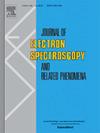Geometry-dependent analysis of 2p3d- and 2p3s-partial fluorescence yield spectra for high-spin 3d5 systems
IF 1.5
4区 物理与天体物理
Q2 SPECTROSCOPY
Journal of Electron Spectroscopy and Related Phenomena
Pub Date : 2025-04-04
DOI:10.1016/j.elspec.2025.147538
引用次数: 0
Abstract
Geometry dependences of partial fluorescence yield (PFY) spectra at the L2,3-edge of 3d transition metals are discussed theoretically and experimentally for high-spin 3d5 systems in Oh and Td point symmetries. Firstly, linear polarized light's propagation direction selection rules for a two-photon process are applied to 2p3d-PFY spectroscopy. Then, the 2p3d-PFY spectra were analyzed by comparison with spectra obtained as partial integration of 2p3d-resonant inelastic X-ray scattering (RIXS) signals, utilizing the relationship between PFY and RIXS spectroscopies: the former is an integration of yield of emitted light at each excitation energy, and the latter is a dispersion of emitted light as a function of emission energy at each excitation energy. Thus, a PFY spectrum can be divided into super PFY (sPFY) spectra using partial integrations of signals on a RIXS map, such as sPFY spectra from elastic and inelastic signals. It is suggested that the origin of the large deviation of 2p3d-PFY spectral shape in a linear-horizontal geometry from a true X-ray absorption spectrum is due to the lack of elastic signals, i.e., the lack of signals emitted when the system returns to its ground state. Contrary to a 2p3d-PFY spectrum, a 2p3s-PFY spectrum is often assumed to have a one-to-one correspondence with true XAS; however, 2p3s-PFY spectroscopy is also a two-photon process that abides by the propagation direction selection rules. We will show theoretically that 2p3s-PFY spectral shapes show a geometry dependence and offer a way to obtain a true X-ray absorption structure from a combination of 2p3s-PFY spectra in linear-vertical and linear-horizontal geometries.
高自旋3d5体系2p3d-和2p3d-部分荧光产额光谱的几何相关分析
本文从理论上和实验上讨论了高自旋3d5体系在Oh和Td点对称下的L2、3边部分荧光产额光谱的几何依赖性。首先,将线偏振光在双光子过程中的传播方向选择规律应用于2p3d-PFY光谱。然后,利用PFY和RIXS光谱之间的关系,将2p3d-PFY光谱与2p3d-谐振非弹性x射线散射(RIXS)信号的部分积分得到的光谱进行对比分析,前者是每个激发能下发射光的产率的积分,后者是每个激发能下发射光的色散作为发射能量的函数。因此,通过对RIXS图上信号的部分积分,例如弹性和非弹性信号的sPFY谱,可以将PFY谱划分为超级PFY (super PFY)谱。提出了2p3d-PFY在线-水平几何形状下的光谱形状与真实x射线吸收光谱偏差较大的原因是缺乏弹性信号,即系统返回基态时缺乏发射的信号。与2p3d-PFY光谱相反,2p3s-PFY光谱通常被认为与真实的XAS具有一对一的对应关系;然而,23s - pfy光谱也是一个遵守传播方向选择规则的双光子过程。我们将从理论上证明2p3s-PFY光谱形状具有几何依赖性,并提供了一种从线性垂直和线性水平几何形状的2p3s-PFY光谱组合中获得真正的x射线吸收结构的方法。
本文章由计算机程序翻译,如有差异,请以英文原文为准。
求助全文
约1分钟内获得全文
求助全文
来源期刊
CiteScore
3.30
自引率
5.30%
发文量
64
审稿时长
60 days
期刊介绍:
The Journal of Electron Spectroscopy and Related Phenomena publishes experimental, theoretical and applied work in the field of electron spectroscopy and electronic structure, involving techniques which use high energy photons (>10 eV) or electrons as probes or detected particles in the investigation.

 求助内容:
求助内容: 应助结果提醒方式:
应助结果提醒方式:


